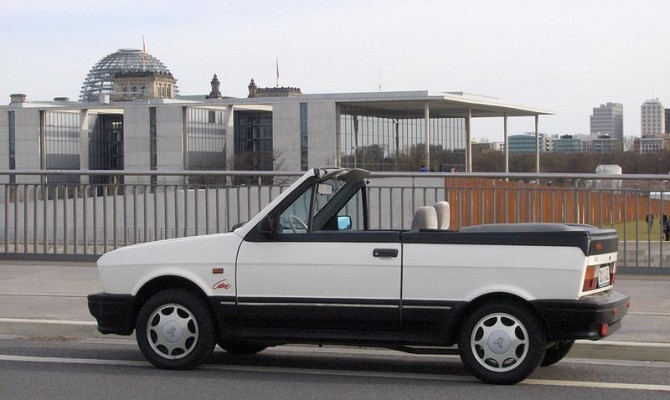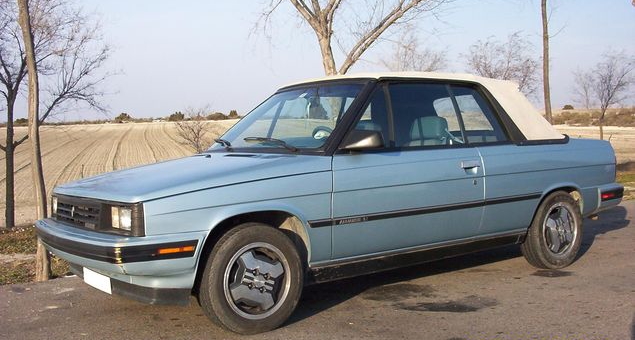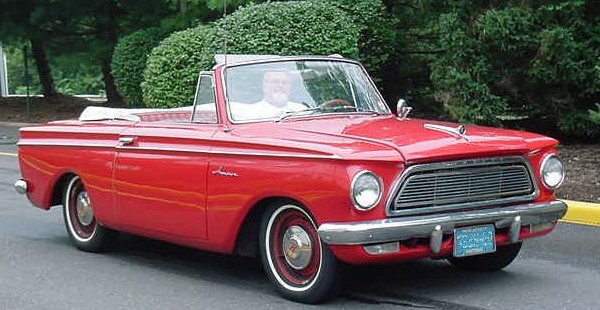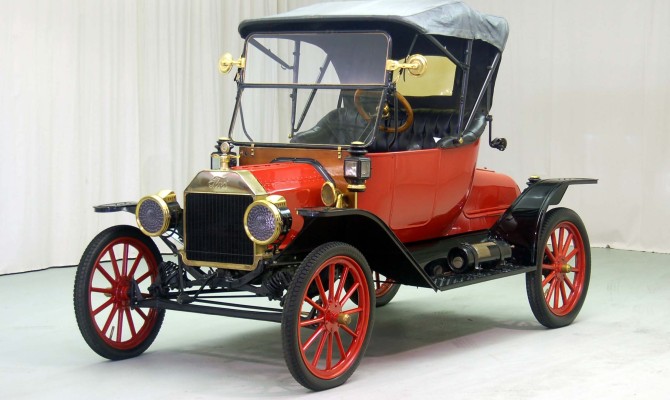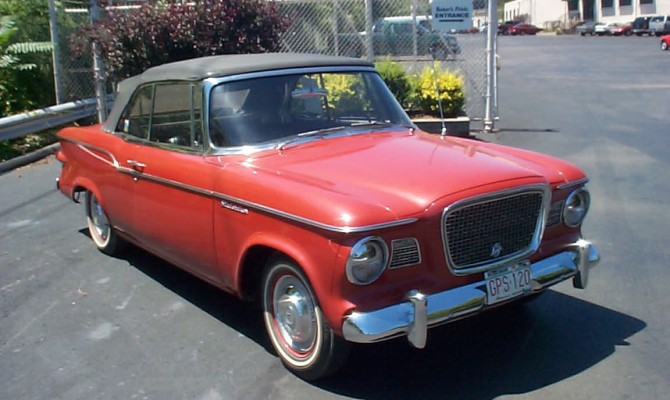by Leon Rochocco, Jr.
“Sex Sells” has long been a popular tenet in advertising.
And sex appeal has typically made it easier to sell cars. The movie industry has always favoured convertibles for their leading men and women, whether Carey Grant, Sophia Loren, Grace Kelly, Kevin Costner or Susan Sarandon.
Virtually any car becomes sexy when you chop the top, but I did say virtually. These five cars resist the glamour and glitz that often come with convertibles.
1985-1987 AMC Alliance Convertible
Built in the United States using a 1.7-litre engine and transmission from Renault, the Alliance was very much French in feeling. It was small, mundane in appearance and less than competitive against the best from Volkswagen, Toyota and Honda. It wasn’t cool with a roof and it didn’t get cooler without one.
A good measure of its appeal then is its collectability and desirability now, which is nil.
1989 Yugo Cabriolet
The formula for the Yugo was simple and it was laughable. Buy a 20-year-old-design of a highly rust-prone Italian economy car, barely update it and ship it to America by the thousands. At first, people will buy a product that is vastly cheaper than the competition, but once the public finds out that it is slow, unattractive, outdated, uncomfortable and minimally reliable, the charm leaves in a hurry.
Did a convertible version help the image and dramatically boost the sales?
Again, the answer was “Not really” – a response that was reinforced by a price that was double the cost of the GV Plus hatchback, which had gained fuel injection and six horsepower.
1960-1963 Studebaker Lark VI Convertible
Solid, sensible and reliable all summed up Studebaker’s Lark. It was a good car without flash or panache, which had limited appeal to car-mad teens.
There’s no question that lowering the top on the Lark made for a pleasant experience, but it didn’t change the status of this car from dud to stud when it came to sex appeal.
1908-1927 Model T Ford
Ford’s Tin Lizzie has always been rugged, reliable and in a class of its own. But sexy? Not likely.
The roadster or touring car versions may be fun, simply because fun goes with open-air motoring like peanut butter goes with jelly. Sex appeal, though, simply isn’t part of the equation with this American icon, though the story would be very different if we were talking about a 1940 Ford Convertible Coupe.
1961-1963 Rambler American
The Rambler had to be one of the most sensible cars built in North America: properly engineered to conservative standards, with incredibly reliable straight-six engines and pricing within reach of middle class budgets. For 1961, the line offered a convertible and it was a lot like its sibling – responsible, sturdy and dull.
In appearance and performance, the new drop-top was essentially an open-air version of an orthopedic shoe. You know, the kind of show that Marilyn Monroe or Angelina Jolie would avoid like the plague. Even spraying pheromones on this car wouldn’t give it an ounce of sex appeal.
Leon Rochocco, Jr. writes for Hagerty Insurance. Hagerty is the world’s leading specialist provider of classic car and boat insurance. Learn more at hagerty.ca.
“The notion that a James Bond villain with unlimited resources would build a flying car out of an AMC Matador is simply unfathomable.”
Casting directors, wardrobe designers and set designers are always recognized for their work in feature films.
However, car-casting people are often the real unsung casting heroes. What would “Bullitt” have been without the Highland Green 1968 Mustang 390 fastback? Just as important are the bit-players, the oddball character actors of the movie car world. These are the Jack Elams, Crispin Glovers and the Peter Lorres of movie cars:
1967 Citroen 2CV — “American Graffiti” The Citroen 2CV is a truly strange car. Perhaps the most intentionally minimalist automobile ever to see production, even third-world motorists today would balk at its hammock-like seats and tin can-like appearance. Future writer and pacifist Curt Henderson (played by Richard Dreyfuss), drove this two-cylinder French peasant’s car throughout the film. Strangely, the producers used a 1967 model in spite of the fact that the film was famously set in 1962. A forgivable oversight given the overall excellence of the film and the fact that one 2CV (produced from 1948-90) looks pretty much like the next.
1953 Messerschmitt KR175 — “The Addams Family” The Messerschmitt KR175 was the product of a company that less than 10 years previous, had been building fighter planes for the Third Reich, including the first jet-powered interceptor. From jet fighters to amusing microcars! This bubble-topped three-wheeler was the ride of the chattering, sentient hairball named Cousin It in the great 1991 re-boot of the Addams Family.
1987 Yugo GV — “Dragnet” After Tom Hanks and Dan Aykroyd lose two previous police-issued vehicles, this was the only car the department would let them have. According to Aykroyd (who did a wicked Jack Webb impersonation), it had been donated to the LAPD by the government of Yugoslavia as a test vehicle “and reflected the cutting edge of Serbo-Croatian technology.” As an aside, the U.S. bombing campaign during the Balkan Wars finally put an end to the Yugo when the factory was levelled. Opinions differ as to the magnitude of this loss to the automotive world.
1974 AMC Matador Coupe — “Man with the Golden Gun” It’s difficult to say what’s stranger, the car or the context. The notion that a James Bond villain with unlimited resources would build a flying car out of an AMC Matador is simply unfathomable in any world other than that of product placement. We like the Matador coupe for its sheer oddness, but the fish-out-of-water aspect of it in a big-budget Bond film is what puts it over the top.
1973 Corvorado — “Live and Let Die” Driven by a Mr. Big henchman (aptly named “Whispers,”) this was a C3 Corvette that was for no apparent reason, customized with Cadillac Eldorado body panels (hence the name Corvorado) by one Les Dunham of Boonton, New Jersey. It pre-dated the Cadillac XLR by some 30 years. The car also made an appearance in the movie “Superfly.”
Rob Sass is the vice-president of content for Hagerty Insurance. Hagerty is the world’s leading specialist provider of classic car and boat insurance. Learn more at hagerty.ca.
Recent Comments
- { Enjoyed your Forest of Bowland in the BMW X5M, particularly the photo of the BMW in front of the main part of Stonyhurst College where... }
- { Bantam designed the Jeep, not Willy's or Ford. The American military gave the original Bantam prototype to Willys and Ford to copy. There is plenty... }
- { All Escalades come with a 6.2-lilter V8 engine that produces 420 horsepower. A six-speed automatic is the only transmission offered and drives the rear wheels.... }
- { Alexandra is an excellent journalist. }
Popular Posts
- Journey to a ‘Sparkling’ Luxury Okanagan Resort “Four lucky readers will put a Dodge Journey’s weekend-...
- The Need For Speed: Hike Those Highway Limits More than half of those polled believe the province sho...
- Drives-U-Crazy… Erratic drivers. An early morning drive from Kelowna to Vancouver is nor...
- Readers Respond: The Pros and Cons of Increasing B.C. Speed Limits Increasing the speed limits will only increase risk to...
- Honda CR-V Review: The Compact Crossover To Get Things Done The CRV is a very stylish and aerodynamic crossover veh...


